Get free scan and check if your device is infected.
Remove it nowTo use full-featured product, you have to purchase a license for Combo Cleaner. Seven days free trial available. Combo Cleaner is owned and operated by RCS LT, the parent company of PCRisk.com.
What is FilesLocker v2.0?
FilesLocker v2.0 (also known as FilesLocker RANSOMWARE v2.0) is a computer infection designed to render data unusable by encryption. Discovered by MalwareHunterTeam, this ransomware-type virus is a new (updated) version of FilesLocker. Once files are encrypted, they are renamed by adding the ".[fileslocker@pm.me]" extension.
For example, "sample.jpg" is renamed to "sample.jpg.[fileslocker@pm.me]", and so on. FilesLocker v2.0 also changes the desktop wallpaper and places two ransom-demand messages (text files called "#DECRYPT MY FILES#.txt" and "#解密我的文件#.txt") on the desktop itself. It also displays a ransom-demand pop-up window.
According to the information provided on FilesLocker v2.0 ransomware's wallpaper (in English and Chinese), all of the victim's files have been encrypted and more details can be found in the "#DECRYPT MY FILES#.txt" or "#解密我的文件#.txt" text files (ransom notes). These files contain information regarding cost of decryption and how to proceed with the decryption process.
The displayed pop-up window states that all files (including photos, videos, documents, music, and so on) have been encrypted and only FilesLocker v2.0 developers can decrypt them or provide victims with a decryption key. They also warn victims that attempts to decrypt files using any third party tools will result in data loss/corruption.
They also offer free decryption of three files as proof that they can be trusted and are capable of decrypting the locked files. To decrypt their remaining files, victims must pay cyber criminals .15 of a Bitcoin (currently equivalent to ~$590) to the payment address provided.
The message in the pop-up window can only be shown only in English and Chinese - the remaining 12 available languages do not work. It is likely that FilesLocker v2.0 developers are the only people who can provide decryption keys, since most of these cyber criminals use cryptography algorithms (symmetric or asymmetric) that generate unique keys and they store them on remote servers (accessible only by them). In any case, cyber criminals cannot be trusted.
They often ignore victims and provide no decryption tools or keys, even if ransoms are paid. As there is no tool capable of cracking FilesLocker v2.0 encryption, the only free solution is to use a backup (if available) and to restore files from there.
Screenshot of a message encouraging users to pay a ransom to decrypt their compromised data:
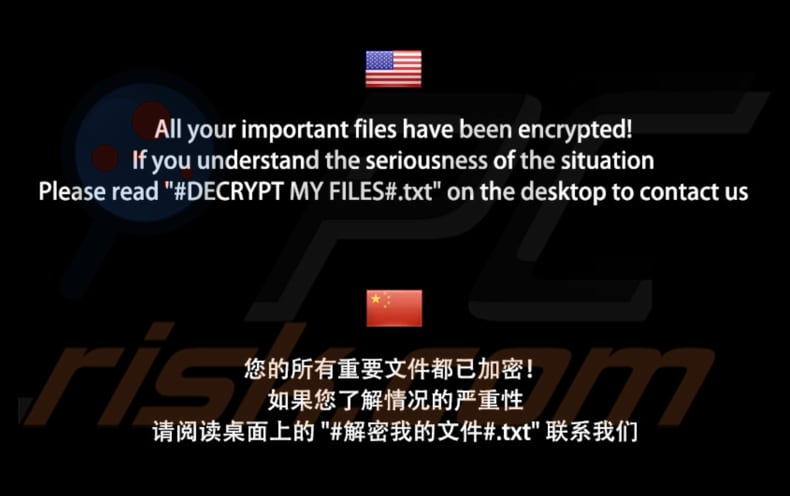
There are many examples of other similar ransomware-type viruses, including GandCrab 5.0.9, CmdRansomware, and Risk. Most serve an identical purpose: to encrypt files stored on victims' computers and keep them locked until ransom demands are met.
These infections sometimes differ in terms of ransom cost and cryptography (symmetric or asymmetric) used for data encryption. Unfortunately, decryption without involvement of ransomware developers is impossible, unless the virus contains bugs, flaws or is not fully developed.
The best way to avoid data loss is to maintain regular backups and store them on a remote server or unplugged storage device.
How did ransomware infect my computer?
It is not clear exactly how FilesLocker v2.0 developers proliferate this ransomware-type virus, however, most cyber criminals proliferate these infections using spam email campaigns, untrustworthy third party software download sources, fake software updaters, or trojans. Spam campaigns proliferate viruses through email attachments (or web links).
Generally, these are malicious/infected Microsoft Office documents, archive files (such as RAR), PDF, executable (.exe) files, and so on.
Once download and opened, these attachments (or links) install viruses. Untrustworthy third party software download sources (such as peer-to-peer networks, free file hosting, freeware download websites, etc.) are used to trick people into installing viruses.
This is achieved by presenting malicious executables (or other files) as legitimate. Various unofficial websites and fake software updaters are also used to proliferate viruses. These updaters install viruses rather than the promised updates or exploit outdated software bugs/flaws .
| Name | FileLocker RANSOMWARE v2.0 |
| Threat Type | Ransomware, Crypto Virus, Files locker |
| Symptoms | Can't open files stored on your computer, previously functional files now have a different extension, for example my.docx.locked. A ransom demanding message is displayed on your desktop. Cyber criminals are asking to pay a ransom (usually in bitcoins) to unlock your files. |
| Distribution methods | Infected email attachments (macros), torrent websites, malicious ads. |
| Damage | All files are encrypted and cannot be opened without paying a ransom. Additional password stealing trojans and malware infections can be installed together with a ransomware infection. |
| Malware Removal (Windows) |
To eliminate possible malware infections, scan your computer with legitimate antivirus software. Our security researchers recommend using Combo Cleaner. Download Combo CleanerTo use full-featured product, you have to purchase a license for Combo Cleaner. 7 days free trial available. Combo Cleaner is owned and operated by RCS LT, the parent company of PCRisk.com. |
How to protect yourself from ransomware infections?
To keep your computer safe, browse the Internet, install, download, and update software with care. Be careful with email attachments (or links) received from unknown, untrustworthy, suspicious email addresses. Do not open the presented files (or links) that are attached to irrelevant emails.
Update your software using implemented functions (or tools) provided by official developers only. Never use third party/unofficial tools. Furthermore, download software using official and trustworthy sources. Bear in mind that download or installation set-ups often contain rogue applications that often cause high-risk computer infections (including ransomware).
Finally, have reputable anti-spyware or anti-virus software installed and keep it enabled at all times. If your computer is already infected with FilesLocker v2.0, we recommend running a scan with Combo Cleaner Antivirus for Windows to automatically eliminate this ransomware.
Screenshot of FilesLocker v2.0 text file (English version):
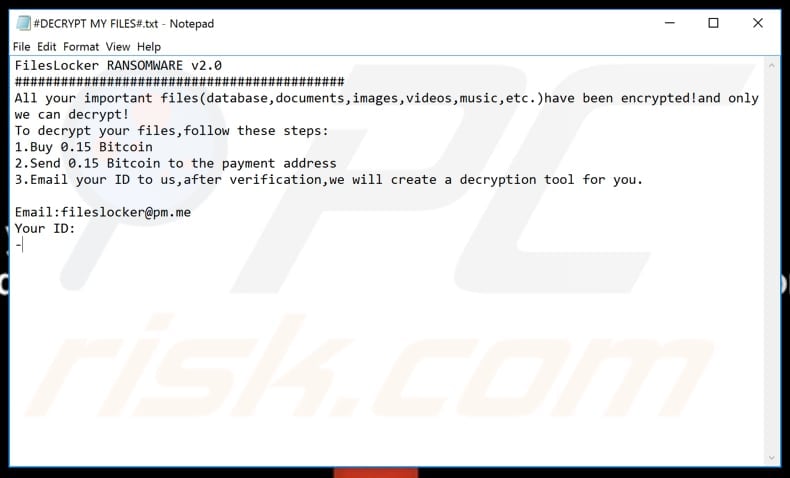
Text presented in FilesLocker v2.0 ransomware text file (English version):
FilesLocker RANSOMWARE v2.0
###########################################
All your important files(database,documents,images,videos,music,etc.)have been encrypted!and only we can decrypt!
To decrypt your files,follow these steps:
1.Buy 0.15 Bitcoin
2.Send 0.15 Bitcoin to the payment address
3.Email your ID to us,after verification,we will create a decryption tool for you.
Email:fileslocker@pm.me
Your ID:
-
Screenshot of FilesLocker v2.0 text file (Chinese version):
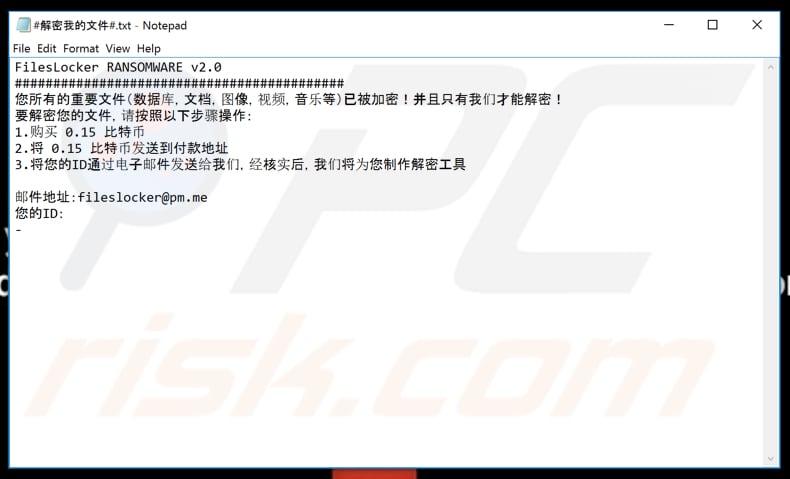
Text presented in FilesLocker v2.0 ransomware text file (Chinese version):
FilesLocker RANSOMWARE v2.0
###########################################
您所有的重要文件(数据库,文档,图像,视频,音乐等)已被加密!并且只有我们才能解密!
要解密您的文件,请按照以下步骤操作:
1.购买 0.15 比特币
2.将 0.15 比特币发送到付款地址
3.将您的ID通过电子邮件发送给我们,经核实后,我们将为您制作解密工具
邮件地址:fileslocker@pm.me
您的ID:
-
Screenshot of FilesLocker v2.0 ransomware pop-up window (English language):
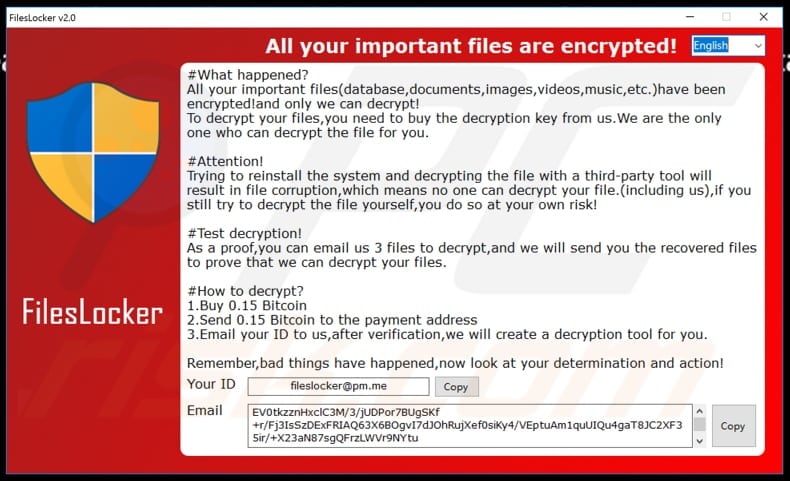
Text presented in FilesLocker v2.0 ransomware pop-up window (English language):
FilesLocker v2.0
All your important files are encrypted!
#What happened?
All your important files(database,documents,images,videos,music,etc.)have been encrypted!and only we can decrypt!
To decrypt your files,you need to buy the decryption key from us.We are the only one who can decrypt the file for you.
#Attention!
Trying to reinstall the system and decrypting the file with a third-party tool will result in file corruption,which means no one can decrypt your file.(including us),if you still try to decrypt the file yourself,you do so at your own risk!
#Test decryption!
As a proof,you can email us 3 files to decrypt,and we will send you the recovered files to prove that we can decrypt your files.
#How to decrypt?
1.Buy 0.15 Bitcoin
2.Send 0.15 Bitcoin to the payment address
3.Email your ID to us,after verification,we will create a decryption tool for you.
Remember,bad things have happened,now look at your determination and action!
Your ID []
Email []
Screenshot of FilesLocker v2.0 ransomware pop-up window (Chinese language):
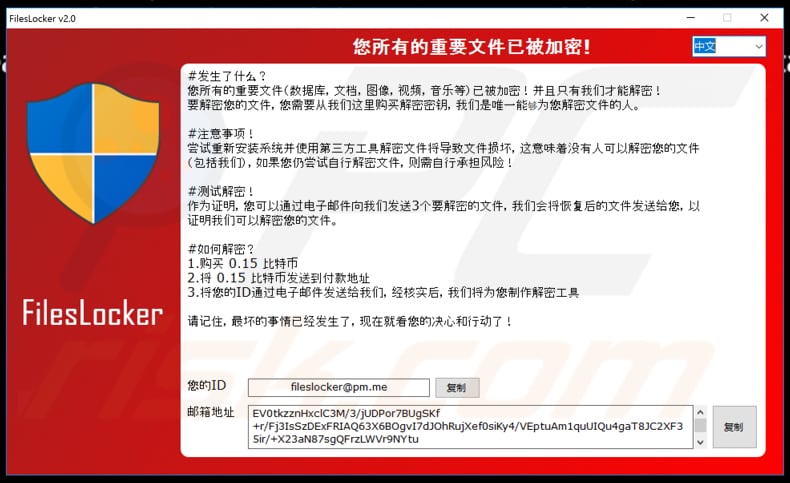
Screenshot of files encrypted by FilesLocker v2.0 (".[fileslocker@pm.me]" extension):
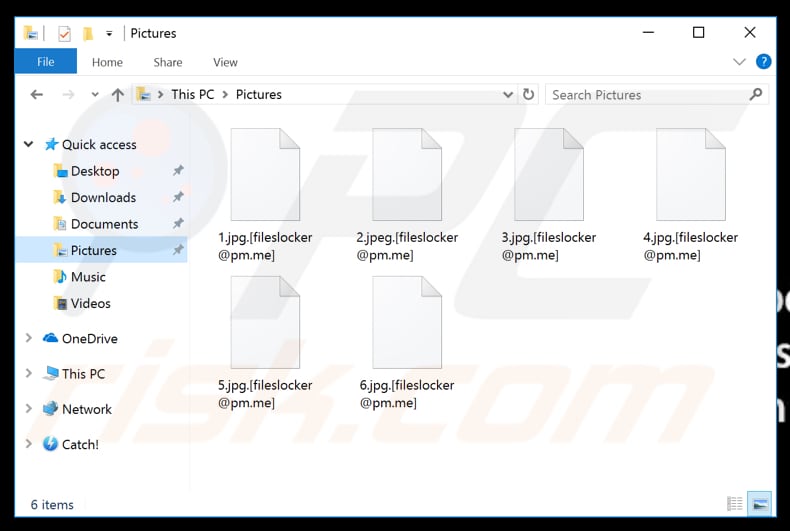
Update 02 January, 2019 - FilesLocker v2.0's developers have recently released an updated version of this ransomware. The updated version uses a different (Christmas-themed) desktop wallpaper and the decryption price is .3 Bitcoin. It also creates different text files. Pop-up window and file extension remains the same.
Screenshot the updated version's desktop wallpaper (encouraging users to read created text files):
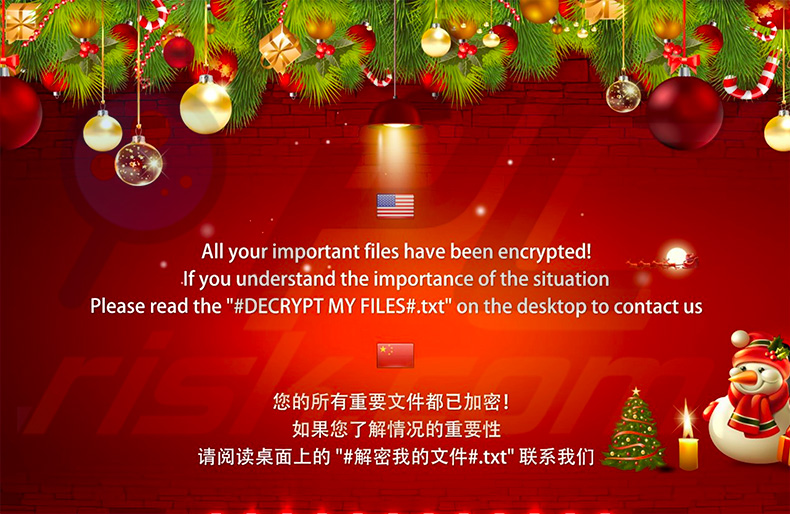
Screenshots of text files created by the updated version (containing ransom-demanding messages in English, Russian and Chinese languages):
Text presented within these text files:
English variant:
FilesLocker RANSOMWARE v2.0
###########################################
#What happened?
All your important files(database,documents,images,videos,music,etc.)have been encrypted!and only we can decrypt!
To decrypt your files,you need to buy the decryption key from us.we are the only one who can decrypt the file for you.
#Attention!
Trying to reinstall the system and decrypting the file with a third-party tool will result in file corruption,which means no one can decrypt your file.(including us)
If you still try to decrypt the file yourself,you do so at your own risk!
#Test decryption!
As a proof,you can email us 3 files to decrypt,and we will send you the recovered files to prove that we can decrypt your files.
#How to decrypt?
1.Buy 0.3 Bitcoin
2.Send 0.3 Bitcoin to the payment address
3.Email your ID to us,after verification,we will create a decryption tool for you.
Email:fileslocker@pm.me
Your ID:
-
****************************************************
Russian variant:
FilesLocker RANSOMWARE v2.0
###########################################
#Что случилось?
Все ваши важные файлы (база данных,документы,изображения,видео,музыка и т. Д.) Были зашифрованы!и только мы можем расшифровать это!
Чтобы расшифровать файл,вам необходимо приобрести у нас ключ дешифрования,и мы единственные,кто может расшифровать файл для вас.
#Внимание!
Попытка переустановить систему и расшифровать файл с помощью стороннего инструмента приведет к повреждению файла, что означает,что никто не сможет расшифровать ваш файл.(включая нас)
Если вы все еще пытаетесь расшифровать файл самостоятельно, вы делаете это на свой страх и риск!
#Проверка расшифровки!
В качестве доказательства вы можете отправить нам 3 файла для расшифровки,и мы вышлем вам восстановленные файлы,чтобы доказать,что мы можем расшифровать ваши файлы.
#Как расшифровать?
1.Покупка 0.3 биткойнов
2.Отправьте 0.3 биткойн на адрес платежа
3.Отправьте нам свой идентификатор,и мы проверим для вас инструмент дешифрования.
Email:fileslocker@pm.me
Ваш ID:
-
****************************************************
Chinese variant:
FilesLocker RANSOMWARE v2.0
###########################################
#发生了什么?
您所有的重要文件(数据库,文档,图像,视频,音乐等)已被加密!并且只有我们才能解密!
要解密您的文件,您需要从我们这里购买解密密钥,我们是唯一能够为您解密文件的人。
#注意事项!
尝试重新安装系统并使用第三方工具解密文件将导致文件损坏,这意味着没有人可以解密您的文件(包括我们)
如果您仍尝试自行解密文件,则需自行承担风险!
#测试解密!
作为证明,您可以通过电子邮件向我们发送3个要解密的文件,我们会将恢复后的文件发送给您,以证明我们可以解密您的文件。
#如何解密?
1.购买 0.3 比特币
2.将 0.3 比特币发送到付款地址
3.将您的ID通过电子邮件发送给我们,经核实后,我们将为您制作解密工具
邮件地址:fileslocker@pm.me
您的ID:
-
At the same time, a malware security researcher Michael Gillespie has released a decryption tool that allows victims restore their data for free (decrypter download link). Therefore, there's no need to pay for anything. However, decrypter requires a ransom note generated by FilesLocker v.2.0 ransomware (Settings -> Load Ransom Note).
Screenshot of the decrypter:
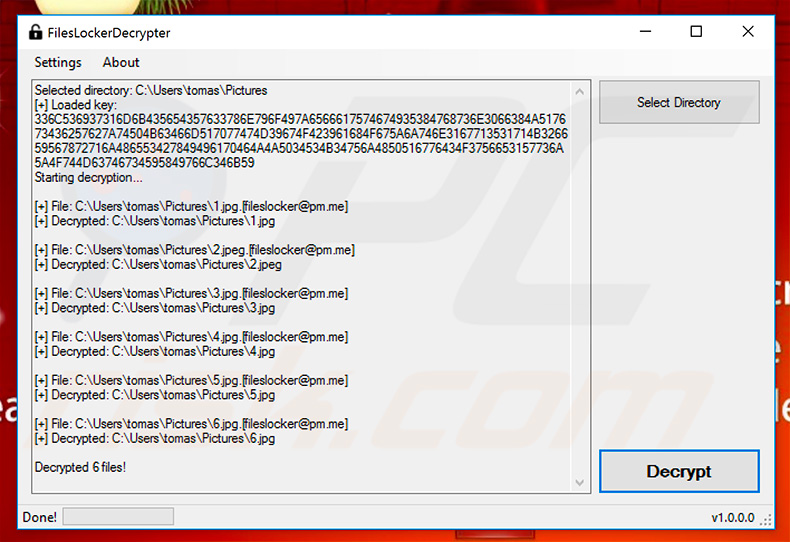
FilesLocker v2.0 ransomware removal:
Instant automatic malware removal:
Manual threat removal might be a lengthy and complicated process that requires advanced IT skills. Combo Cleaner is a professional automatic malware removal tool that is recommended to get rid of malware. Download it by clicking the button below:
DOWNLOAD Combo CleanerBy downloading any software listed on this website you agree to our Privacy Policy and Terms of Use. To use full-featured product, you have to purchase a license for Combo Cleaner. 7 days free trial available. Combo Cleaner is owned and operated by RCS LT, the parent company of PCRisk.com.
Video suggesting what steps should be taken in case of a ransomware infection:
Quick menu:
- What is FileLocker RANSOMWARE v2.0?
- STEP 1. Reporting ransomware to authorities.
- STEP 2. Isolating the infected device.
- STEP 3. Identifying the ransomware infection.
- STEP 4. Searching for ransomware decryption tools.
- STEP 5. Restoring files with data recovery tools.
- STEP 6. Creating data backups.
If you are a victim of a ransomware attack we recommend reporting this incident to authorities. By providing information to law enforcement agencies you will help track cybercrime and potentially assist in the prosecution of the attackers. Here's a list of authorities where you should report a ransomware attack. For the complete list of local cybersecurity centers and information on why you should report ransomware attacks, read this article.
List of local authorities where ransomware attacks should be reported (choose one depending on your residence address):
USA - Internet Crime Complaint Centre IC3
United Kingdom - Action Fraud
Spain - Policía Nacional
France - Ministère de l'Intérieur
Germany - Polizei
Italy - Polizia di Stato
The Netherlands - Politie
Poland - Policja
Portugal - Polícia Judiciária
Isolating the infected device:
Some ransomware-type infections are designed to encrypt files within external storage devices, infect them, and even spread throughout the entire local network. For this reason, it is very important to isolate the infected device (computer) as soon as possible.
Step 1: Disconnect from the internet.
The easiest way to disconnect a computer from the internet is to unplug the Ethernet cable from the motherboard, however, some devices are connected via a wireless network and for some users (especially those who are not particularly tech-savvy), disconnecting cables may seem troublesome. Therefore, you can also disconnect the system manually via Control Panel:
Navigate to the "Control Panel", click the search bar in the upper-right corner of the screen, enter "Network and Sharing Center" and select search result: 
Click the "Change adapter settings" option in the upper-left corner of the window: 
Right-click on each connection point and select "Disable". Once disabled, the system will no longer be connected to the internet. To re-enable the connection points, simply right-click again and select "Enable". 
Step 2: Unplug all storage devices.
As mentioned above, ransomware might encrypt data and infiltrate all storage devices that are connected to the computer. For this reason, all external storage devices (flash drives, portable hard drives, etc.) should be disconnected immediately, however, we strongly advise you to eject each device before disconnecting to prevent data corruption:
Navigate to "My Computer", right-click on each connected device, and select "Eject": 
Step 3: Log-out of cloud storage accounts.
Some ransomware-type might be able to hijack software that handles data stored within "the Cloud". Therefore, the data could be corrupted/encrypted. For this reason, you should log-out of all cloud storage accounts within browsers and other related software. You should also consider temporarily uninstalling the cloud-management software until the infection is completely removed.
Identify the ransomware infection:
To properly handle an infection, one must first identify it. Some ransomware infections use ransom-demand messages as an introduction (see the WALDO ransomware text file below).

This, however, is rare. In most cases, ransomware infections deliver more direct messages simply stating that data is encrypted and that victims must pay some sort of ransom. Note that ransomware-type infections typically generate messages with different file names (for example, "_readme.txt", "READ-ME.txt", "DECRYPTION_INSTRUCTIONS.txt", "DECRYPT_FILES.html", etc.). Therefore, using the name of a ransom message may seem like a good way to identify the infection. The problem is that most of these names are generic and some infections use the same names, even though the delivered messages are different and the infections themselves are unrelated. Therefore, using the message filename alone can be ineffective and even lead to permanent data loss (for example, by attempting to decrypt data using tools designed for different ransomware infections, users are likely to end up permanently damaging files and decryption will no longer be possible even with the correct tool).
Another way to identify a ransomware infection is to check the file extension, which is appended to each encrypted file. Ransomware infections are often named by the extensions they append (see files encrypted by Qewe ransomware below).

This method is only effective, however, when the appended extension is unique - many ransomware infections append a generic extension (for example, ".encrypted", ".enc", ".crypted", ".locked", etc.). In these cases, identifying ransomware by its appended extension becomes impossible.
One of the easiest and quickest ways to identify a ransomware infection is to use the ID Ransomware website. This service supports most existing ransomware infections. Victims simply upload a ransom message and/or one encrypted file (we advise you to upload both if possible).

The ransomware will be identified within seconds and you will be provided with various details, such as the name of the malware family to which the infection belongs, whether it is decryptable, and so on.
Example 1 (Qewe [Stop/Djvu] ransomware):

Example 2 (.iso [Phobos] ransomware):

If your data happens to be encrypted by ransomware that is not supported by ID Ransomware, you can always try searching the internet by using certain keywords (for example, a ransom message title, file extension, provided contact emails, crypto wallet addresses, etc.).
Search for ransomware decryption tools:
Encryption algorithms used by most ransomware-type infections are extremely sophisticated and, if the encryption is performed properly, only the developer is capable of restoring data. This is because decryption requires a specific key, which is generated during the encryption. Restoring data without the key is impossible. In most cases, cybercriminals store keys on a remote server, rather than using the infected machine as a host. Dharma (CrySis), Phobos, and other families of high-end ransomware infections are virtually flawless, and thus restoring data encrypted without the developers' involvement is simply impossible. Despite this, there are dozens of ransomware-type infections that are poorly developed and contain a number of flaws (for example, the use of identical encryption/decryption keys for each victim, keys stored locally, etc.). Therefore, always check for available decryption tools for any ransomware that infiltrates your computer.
Finding the correct decryption tool on the internet can be very frustrating. For this reason, we recommend that you use the No More Ransom Project and this is where identifying the ransomware infection is useful. The No More Ransom Project website contains a "Decryption Tools" section with a search bar. Enter the name of the identified ransomware, and all available decryptors (if there are any) will be listed.

Restore files with data recovery tools:
Depending on the situation (quality of ransomware infection, type of encryption algorithm used, etc.), restoring data with certain third-party tools might be possible. Therefore, we advise you to use the Recuva tool developed by CCleaner. This tool supports over a thousand data types (graphics, video, audio, documents, etc.) and it is very intuitive (little knowledge is necessary to recover data). In addition, the recovery feature is completely free.
Step 1: Perform a scan.
Run the Recuva application and follow the wizard. You will be prompted with several windows allowing you to choose what file types to look for, which locations should be scanned, etc. All you need to do is select the options you're looking for and start the scan. We advise you to enable the "Deep Scan" before starting, otherwise, the application's scanning capabilities will be restricted.

Wait for Recuva to complete the scan. The scanning duration depends on the volume of files (both in quantity and size) that you are scanning (for example, several hundred gigabytes could take over an hour to scan). Therefore, be patient during the scanning process. We also advise against modifying or deleting existing files, since this might interfere with the scan. If you add additional data (for example, downloading files/content) while scanning, this will prolong the process:

Step 2: Recover data.
Once the process is complete, select the folders/files you wish to restore and simply click "Recover". Note that some free space on your storage drive is necessary to restore data:

Create data backups:
Proper file management and creating backups is essential for data security. Therefore, always be very careful and think ahead.
Partition management: We recommend that you store your data in multiple partitions and avoid storing important files within the partition that contains the entire operating system. If you fall into a situation whereby you cannot boot the system and are forced to format the disk on which the operating system is installed (in most cases, this is where malware infections hide), you will lose all data stored within that drive. This is the advantage of having multiple partitions: if you have the entire storage device assigned to a single partition, you will be forced to delete everything, however, creating multiple partitions and allocating the data properly allows you to prevent such problems. You can easily format a single partition without affecting the others - therefore, one will be cleaned and the others will remain untouched, and your data will be saved. Managing partitions is quite simple and you can find all the necessary information on Microsoft's documentation web page.
Data backups: One of the most reliable backup methods is to use an external storage device and keep it unplugged. Copy your data to an external hard drive, flash (thumb) drive, SSD, HDD, or any other storage device, unplug it and store it in a dry place away from the sun and extreme temperatures. This method is, however, quite inefficient, since data backups and updates need to be made regularly. You can also use a cloud service or remote server. Here, an internet connection is required and there is always the chance of a security breach, although it's a really rare occasion.
We recommend using Microsoft OneDrive for backing up your files. OneDrive lets you store your personal files and data in the cloud, sync files across computers and mobile devices, allowing you to access and edit your files from all of your Windows devices. OneDrive lets you save, share and preview files, access download history, move, delete, and rename files, as well as create new folders, and much more.
You can back up your most important folders and files on your PC (your Desktop, Documents, and Pictures folders). Some of OneDrive’s more notable features include file versioning, which keeps older versions of files for up to 30 days. OneDrive features a recycling bin in which all of your deleted files are stored for a limited time. Deleted files are not counted as part of the user’s allocation.
The service is built using HTML5 technologies and allows you to upload files up to 300 MB via drag and drop into the web browser or up to 10 GB via the OneDrive desktop application. With OneDrive, you can download entire folders as a single ZIP file with up to 10,000 files, although it can’t exceed 15 GB per single download.
OneDrive comes with 5 GB of free storage out of the box, with an additional 100 GB, 1 TB, and 6 TB storage options available for a subscription-based fee. You can get one of these storage plans by either purchasing additional storage separately or with Office 365 subscription.
Creating a data backup:
The backup process is the same for all file types and folders. Here’s how you can back up your files using Microsoft OneDrive
Step 1: Choose the files/folders you want to backup.

Click the OneDrive cloud icon to open the OneDrive menu. While in this menu, you can customize your file backup settings.

Click Help & Settings and then select Settings from the drop-down menu.

Go to the Backup tab and click Manage backup.

In this menu, you can choose to backup the Desktop and all of the files on it, and Documents and Pictures folders, again, with all of the files in them. Click Start backup.
Now, when you add a file or folder in the Desktop and Documents and Pictures folders, they will be automatically backed up on OneDrive.
To add folders and files, not in the locations shown above, you have to add them manually.

Open File Explorer and navigate to the location of the folder/file you want to backup. Select the item, right-click it, and click Copy.

Then, navigate to OneDrive, right-click anywhere in the window and click Paste. Alternatively, you can just drag and drop a file into OneDrive. OneDrive will automatically create a backup of the folder/file.

All of the files added to the OneDrive folder are backed up in the cloud automatically. The green circle with the checkmark in it indicates that the file is available both locally and on OneDrive and that the file version is the same on both. The blue cloud icon indicates that the file has not been synced and is available only on OneDrive. The sync icon indicates that the file is currently syncing.

To access files only located on OneDrive online, go to the Help & Settings drop-down menu and select View online.

Step 2: Restore corrupted files.
OneDrive makes sure that the files stay in sync, so the version of the file on the computer is the same version on the cloud. However, if ransomware has encrypted your files, you can take advantage of OneDrive’s Version history feature that will allow you to restore the file versions prior to encryption.
Microsoft 365 has a ransomware detection feature that notifies you when your OneDrive files have been attacked and guide you through the process of restoring your files. It must be noted, however, that if you don’t have a paid Microsoft 365 subscription, you only get one detection and file recovery for free.
If your OneDrive files get deleted, corrupted, or infected by malware, you can restore your entire OneDrive to a previous state. Here’s how you can restore your entire OneDrive:

1. If you're signed in with a personal account, click the Settings cog at the top of the page. Then, click Options and select Restore your OneDrive.
If you're signed in with a work or school account, click the Settings cog at the top of the page. Then, click Restore your OneDrive.
2. On the Restore your OneDrive page, select a date from the drop-down list. Note that if you're restoring your files after automatic ransomware detection, a restore date will be selected for you.
3. After configuring all of the file restoration options, click Restore to undo all the activities you selected.
The best way to avoid damage from ransomware infections is to maintain regular up-to-date backups.
Share:

Tomas Meskauskas
Expert security researcher, professional malware analyst
I am passionate about computer security and technology. I have an experience of over 10 years working in various companies related to computer technical issue solving and Internet security. I have been working as an author and editor for pcrisk.com since 2010. Follow me on Twitter and LinkedIn to stay informed about the latest online security threats.
PCrisk security portal is brought by a company RCS LT.
Joined forces of security researchers help educate computer users about the latest online security threats. More information about the company RCS LT.
Our malware removal guides are free. However, if you want to support us you can send us a donation.
DonatePCrisk security portal is brought by a company RCS LT.
Joined forces of security researchers help educate computer users about the latest online security threats. More information about the company RCS LT.
Our malware removal guides are free. However, if you want to support us you can send us a donation.
Donate
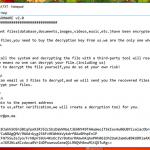
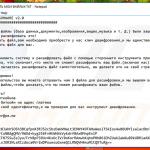
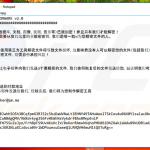
▼ Show Discussion